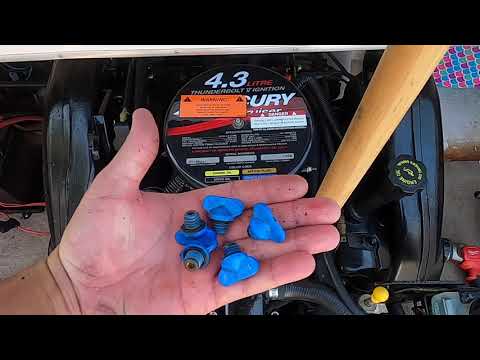Chain O’ Lakes Boaters, it’s that time of year again! Unfortunately, sun & boating season are ending, so it’s time to think about winterizing your boat. But, before those freezing temperatures set in and you decide on the best option for storing your vessel, you’ll need to prepare it for its hibernation.
Step #1. Drain the engine
For inboards and stern drives, you’ll need to locate and open the petcocks underneath the manifolds and on the sides of the engine block. Some engines will have bronze plugs similar to bilge plugs. Next, remove the water-pump hose from the bottom to let it drain completely.
Draining the engine will ensure the water in the cooling chambers can’t freeze, expand and crack the engine block and manifolds, costing you up to tens of thousands of your hard-earned cash.

Step #2. Check the hull
While fiberglass is made to stand up to the sun, sand, and saltwater, some snow will be its kryptonite. Snow eventually becomes ice, and when water freezes, it spreads, which can cause open hatches and window tracks to split, causing leaks. If you plan on utilizing outdoor storage, your boat will need a cover.
You should also check for stress cracks around the bow eye and Gelcoat blisters as they indicate structural damage. Accordingly, a professional should look at it if this is the case. Next, If your hull is aluminum, bang the drum slowly with a rubber mallet to knock out dents. After you work out your frustrations on the hull, scrape off any barnacles, and other unwelcome hitchhikers stuck to your boat’s bottom and sand away any residue. Finally, a power wash will remove all other sea scum and dirt.
Step #3. Replace engine oil
Changing the engine oil is a must to eliminate moisture and prevent corrosion, as old oil in the crankcase of a stored boat forms acids. Extra water and humidity cause excessive wear, leading to loss of power, poor fuel economy, and possible engine failure.
Step#4. Fog the engine
Just as changing the oil prevents corrosion, fogging prevents corrosion of inboard or outboard engines stored for an extended period. Fogging oils and sprays are specially formulated to penetrate deep into the engine and coat parts with a protective layer of anti-corrosive compound until spring.
Hook “ear muffs” and a garden hose to the engine, start it, and then spray the fogging-solution lubricant directly into the air intake until it’s gone.
Step #5. Add a high-quality fuel stabilizer
The next step is to treat your boat’s fuel with a stabilizer to ensure carburetors and fuel injectors won’t get clogged with varnish deposits that ruin fuel systems. After adding the stabilizer to the fuel, run the engine for at least ten minutes, so it circulates throughout the engine.
Step #6. Drain gear-case lubricant
Check the color of the liquid while draining the gear case, as it will indicate potential issues. If it’s clear or amber-colored, the gear-case is well lubricated. If it’s milk-colored, there may be water in the oil, meaning you’ll want to replace the seals over the wintertime. If tiny chips of metal flow out, your gears are likely grinding against each other.
Step #7. Fill the engine block with antifreeze
Filling the engine block with antifreeze will prevent residual water from freezing and cracking. A non-toxic propylene glycol antifreeze is best, and your location should determine its strength.
Step #8. Grease gears and fittings
You’ll likely locate your engine’s grease fittings in the steering mechanism area. Use a high-quality marine lubricant to protect against rust, corrosion, and oxidation. In addition, the owner’s manual should list other vital areas that need greasing before winter storage.
Step #9. Drain fresh water plumbing systems
Heads, sinks, tanks, and anywhere else, water accumulated during the season must be drained and pumped full with antifreeze to protect them and prevent moisture from gathering as you wait for the next boating season. Additionally, drain the other internal systems like the bilge (remove the plug to prevent moisture build-up in the hull) and raw water washdowns.
Step #10. Prevent mold and mildew buildup
The humidity of your boat’s cabin may cause mold and mildew during its time in winter storage. The musty odor aside, mold and mildew can permanently damage upholstery and, worse, lead to respiratory illness in sensitive individuals. Below are some measures to consider:
Ventilate: You can use a device like cowl ventilators, clamshell ventilators, and louvered ventilators or use a shrink wrap ventilators.
Dehumidify: You can reduce humidity with specialty moisture absorbing crystals from Star Brite, Mary Kate, and other manufacturers.
Treat: Or, use chlorine dioxide technology to treat the boat’s cabin during storage or when recommissioning in the spring.
Step #11. Remove valuables
Boatyards rarely see people during the winter, which makes break-ins easy. To prevent your valuables from getting stolen, remove expensive electronics and other costly items from your vessel. In addition, your boat should have insurance, even when it’s not on the water.
Step #12. Remove or disconnect batteries
This is an optional step, but it’s wise to remove and charge your batteries while your boat is in storage. In any case, disconnect the cables or move the battery to the offsetting and take any on-marinized electronics indoors.
Step #13. Cover your boat
Finally, regardless of if your vessel is heading to storage, shield your boat with a durable cover or shrink wrap.
